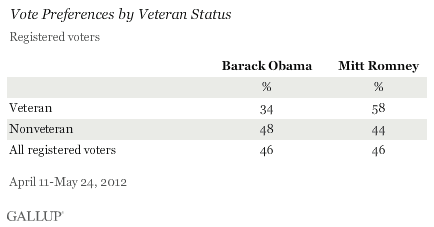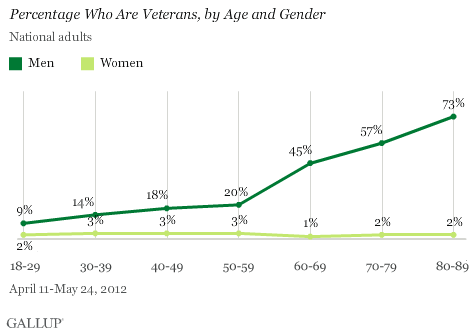PRINCETON, NJ -- U.S. veterans, about 13% of the adult population and consisting mostly of older men, support Mitt Romney over Barack Obama for president by 58% to 34%, while nonveterans give Obama a four-percentage-point edge.

These data, from an analysis of Gallup Daily tracking interviews conducted April 11-May 24, show that 24% of all adult men are veterans, compared with 2% of adult women.
Obama and Romney are tied overall at 46% apiece among all registered voters in this sample. Men give Romney an eight-point edge, while women opt for Obama over Romney by seven points. It turns out that the male skew for Romney is driven almost entirely by veterans. Romney leads by one point among nonveteran men, contrasted with the 28-point edge Romney receives among male veterans.

The small percentage of female veterans in the U.S., in contrast to their male counterparts, do not differ significantly in their presidential vote choice from the vast majority of women who are not veterans.
The proportion of U.S. men who are armed forces veterans rises dramatically among those who are 60 and older. The military draft was in force in the U.S. from shortly before the U.S. entry into World War II until the early 1970s. A majority of men now 70 to 89 served in the military, including almost three-quarters of those aged 80 to 89. Less than a fifth of men younger than 50 have served in the military. There is little variation in military service among women across these age groups.

Age makes little substantive difference in the vote preferences of male veterans. Those younger than 50 are roughly as likely to support Romney as are those 60 and older. Male veterans aged 50 to 59 are slightly less skewed toward Romney, but still support him by a 15-point margin.

Bottom Line
Veterans in the U.S. today are mostly male and two-thirds are aged 50 or older. In a population that is currently evenly split in its preferences for Barack Obama or Mitt Romney for president, veterans stand out for their 24-point preference for Romney. About a fourth of men are veterans, and it is their strong skew toward Romney that essentially creates the GOP candidate's leading position among men today. Among nonveteran men, Obama and Romney are essentially tied.
Why veterans are so strong in their preference for the Republican presidential candidate is not clear. Previous Gallup analysis has suggested that two processes may be at work. Men who serve in the military may become socialized into a more conservative orientation to politics as a result of their service. Additionally, men who in the last decades have chosen to enlist in the military may have a more Republican orientation to begin with.
Veterans' strong preference for Romney in this election occurs even though Romney himself is not a military veteran -- though Obama shares this nonveteran status. This will be the first election since World War II in which neither major-party candidate is a veteran.
Barring unforeseen developments such as the re-institution of the military draft, the proportion of the male population in this country that will have served in the armed forces will decrease in the years ahead as the older population dominated by veterans dies off. These data suggest that Democrats could get an overall boost from this demographic phenomenon as these apparently reliable Republican voters become a smaller and smaller proportion of the population.
Survey Methods
Results are based on telephone interviews conducted as part of Gallup Daily tracking April 11-May 24, 2012, with a random sample of 43,352 adults, aged 18 and older, living in all 50 U.S. states and the District of Columbia.
For results based on the total sample of national adults, one can say with 95% confidence that the maximum margin of sampling error is ±1 percentage point.
Other results are based on telephone interviews conducted as part of Gallup Daily tracking April 11-May 24, 2012, with a random sample of 7,133 veterans, aged 18 and older, living in all 50 U.S. states and the District of Columbia. For results based on this sample, one can say with 95% confidence that the maximum margin of sampling error is ±2 percentage points.
For results based on the sample of 3,327 veterans who are registered voters and asked the presidential election ballot question, one can say with 95% confidence that the maximum margin of sampling error is ±2 percentage points.
The margin of error for other subsamples used in this analysis will vary, depending on sample size.
Interviews are conducted with respondents on landline telephones and cellular phones, with interviews conducted in Spanish for respondents who are primarily Spanish-speaking. Each sample includes a minimum quota of 400 cell phone respondents and 600 landline respondents per 1,000 national adults, with additional minimum quotas among landline respondents by region. Landline telephone numbers are chosen at random among listed telephone numbers. Cell phone numbers are selected using random-digit-dial methods. Landline respondents are chosen at random within each household on the basis of which member had the most recent birthday.
Samples are weighted by gender, age, race, Hispanic ethnicity, education, region, adults in the household, and phone status (cell phone only/landline only/both, cell phone mostly, and having an unlisted landline number). Demographic weighting targets are based on the March 2011 Current Population Survey figures for the aged 18 and older non-institutionalized population living in U.S. telephone households. All reported margins of sampling error include the computed design effects for weighting and sample design.
In addition to sampling error, question wording and practical difficulties in conducting surveys can introduce error or bias into the findings of public opinion polls.
For more details on Gallup's polling methodology, visit www.gallup.com.
